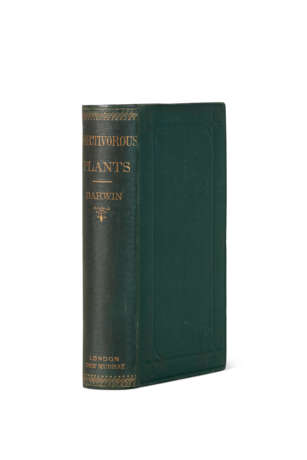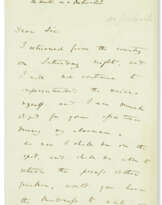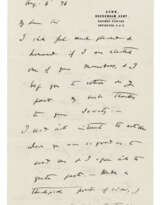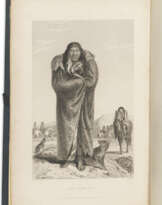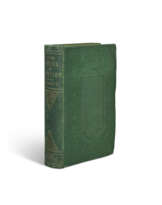ID 1032690
Lot 38 | Presentation copy of Insectivorous Plants
Estimate value
$ 15 000 – 25 000
Presentation copy of the first edition to one of the book’s reviewers. Darwin’s classic study of insectivorous plants, the first research he embarked upon immediately after the publication of the Origin in November 1859. Darwin was on holiday in Sussex in the summer of 1860, where he became fascinated by the insectivorous sundews (Drosera) that grew on the heathland. He began experimenting on them, and became so obsessed that he wrote to Charles Lyell that autumn: “I will & must finish my Drosera M.S. which will take me a week, for at this present moment I care more about Drosera than the origin of all the species in the world … Is it not curious that a plant sh[ou]d be far more sensitive to a touch than any nerve in the human body!” He continued to experiment on Drosera and other insectivorous plants, but had to put off his researches for more than ten years, due to health issues and other works in progress. With the help of Joseph Hooker and others he renewed his research and finished his 462-page Insectivorous Plants. The work forms a “contribution to the evolutionary series by the study of the adaptations of such plants to impoverished conditions” (Freeman).
“Darwin initially wanted to publish Insectivorous Plants and a second edition of Climbing Plants together in the same book but his publisher John Murray found the manuscript so large that it was decided to publish them separately. This was despite setting the technical details in smaller type, a technique to reduce the page count used in Cirripedia and Variation … Darwin agreed with Murray on an initial print run of 1250, forgoing his profits until 750 or 800 had been sold, because he thought that would be all that would ever sell of such technical book that was unlikely to go into a second edition. Insectivorous Plants was published on 2 July 1875 and it was immediately clear that Darwin had been too desponding about the potential sales of the work, as 1700 copies sold straight away. A second and third thousand copies were printed off quickly with a fourth thousand following in 1876” (University of Cambridge, Darwin Correspondence Project online).
The recipient of this presentation copy was Alfred William Bennett (1833–1902), a Quaker botanist and publisher best known for his work on cryptogams, and on the flora of the Swiss Alps. He is referred to several times in the text of this work. Bennett published a two-part review of Insectivorous Plants, which appeared in the 15 July and 22 July 1875 issues of Nature. Bennett is named as one of the recipients in Darwin’s list for presentation copies. See Darwin Correspondence Project. Freeman 1217; Norman 601.
Octavo (184 x 120mm). With 30 wood engravings in text, two of which are after Charles Darwin's own drawings and others after drawings by his sons, George and Francis (S1-S2 with a short edge tear). Original blindstamped green cloth, spine gilt-lettered, top edge trimmed (recased with a little repair at spine ends, endpapers rubbed, f.f.e. with two small tears). Provenance: Alfred W. Bennett (presentation inscription in Murray’s clerk’s hand on half-title—the same hand which inscribed most of Darwin’s presentation copies of this period; ownership signature in pencil on half-title; a few pencil emphasis marks).
| Artist: | Charles Robert Darwin (1809 - 1882) |
|---|---|
| Place of origin: | England |
| Auction house category: | Medicine & science, Printed books |
| Artist: | Charles Robert Darwin (1809 - 1882) |
|---|---|
| Place of origin: | England |
| Auction house category: | Medicine & science, Printed books |
| Address of auction |
CHRISTIE'S 20 Rockefeller Plaza 10020 New York USA | ||||||||||||||
|---|---|---|---|---|---|---|---|---|---|---|---|---|---|---|---|
| Preview |
| ||||||||||||||
| Phone | +1 212 636 2000 | ||||||||||||||
| Fax | +1 212 636 4930 | ||||||||||||||
| Conditions of purchase | Conditions of purchase | ||||||||||||||
| Shipping |
Postal service Courier service pickup by yourself | ||||||||||||||
| Payment methods |
Wire Transfer | ||||||||||||||
| Business hours | Business hours
|
